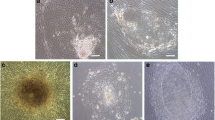Abstract
Homologous feeder culture system can efficiently promote the proliferation of embryonic germ (EG) cells or embryonic stem (ES) cells while avoiding contamination by exogenous proteins and pathogens. In this study, we compared the potency of using homologous porcine embryonic fibroblasts (PEFs), gonadal stromal cells (GSCs), porcine adipose–derived stem cells (PASCs), or porcine amniotic fluid stem (PAFS) cells as feeder cells for porcine EG growth, with the commonly used mouse embryonic fibroblasts (MEFs). We compared the feeder cell growth rates; secretion of growth factors including stem cell factor (SCF), basic fibroblast growth factor (bFGF), and leukemia inhibitory factor (LIF); the effects of growth factors on porcine PGC growth; and EG growth rates when individual cells were used as feeders. Our results showed that feeder cells secreted limited amounts of growth factors, and supplementation of growth factors can significantly improve the formation of EG colonies and number of passages (P < 0.05). GSC and PEF were more suitable for EG growth because of their faster growth rate and their support on EG growth. In conclusion, this study identified novel homologous cells that can be used for EG production.




Similar content being viewed by others
References
Catharina E, Raimund S, Karina M, Katarina A, Christina B, Kersti L (2006) Derivation of a xeno-free human embryonic Stem cell line. Stem Cells 24:2170–2176
Cho M, Lee EJ, Nam H, Yang JH, Cho J, Lim JM, Lee G (2010) Human feeder layer system derived from umbilicalcord stromal cells for human embryonic stem cells. Fertil Steril 93(8):2525–2531
Cong YM, Ma J, Sun RZ, Wang JY, Xue BH, Wang JQ (2013) Derivation of putative porcine embryonic germ cells and analysis of their multi-lineage differentiation potential. J Gen Genomics 40:453–464
Dong X, Li Y, Wang H (2016) Optimization of culture conditions for porcine embryonic germ cells. In Vitro Cell Dev Biol Anim 52:131–136
Dong X, Tsung H, Mu Y, Liu L, Chen H, Zhang L (2014) Generation of chimeric piglets by injection of embryonic germ cells from inbred Wuzhishan miniature pigs into blastocysts. Xenotransplantation 21:140–148
Evans MJ, Kaufman MH (1981) Establishment in culture of pluripotential cells from mouse embryos. Nature 292(5819):154–156
Jin H, Ying W, Yu LL (2007) Fibroblast-like cells derived from the gonadal ridges and dorsal mesenteries of human embryos as feedercells for the culture of human embryonic germ cells. J Biomed Sci 14:617–628
Matsui Y, Zsebo K, Hogan B (1992) Derivation of pluripotential embryonic stem cells from murine primordial germ cells in culture. Cell 70:841–847
Mueller S, Prelle K, Rieger N (1999) Chimeric pigs following blastocyst injection of transgenic porcine primordial germ cells. Mol Reprod Dev 54:244–254
Park Y, Choi IY, Lee SJ, Lee SR, Sung HJ, Kim JH, Yoo YD, Geum DH, Kim SH, Kim BS (2010) Undifferentiated propagation of the human embryonic stem cell lines, H1 and HSF6, on human placenta derived feeder cells without basic fibroblast growth factor supplementation. Stem Cells Dev 19:1713–1722
Petkov S, Marksb H, Klein T, Garcia RS, Gao Y, Stunnenberg H (2011) In vitro culture and characterization of putative porcine embryonic germ cells derived from domestic breeds and Yucatan mini pig embryos at Days 20–24 of gestation. Stem Cell Res 6:226–237
Piedrahita JA, Moore K, Oetama B, Lee CK, Scales N, Jagdeece R (1998) Generation of transgenic porcine chimeras using primordial germ cell-derived colonies. Biol Reprod 58(5):1321–1329
Richards M, Tan S, Fong CY, Biswas A, Chan WK, Bongso A (2003) Comparative evaluation of various human feeders for prolonged undifferentiated growth of human embryonic stem cells. Stem Cells 21:546–556
Shim H, Gutiérres-Adán A, Chen LR, BonDurant R, Behboodi E, Anderson G (1997) Isolation of pluripotent stem cells from cultured porcine primordial germ cells. Biol Reprod 57(5):1089–1095
Shiue YL, Yang JR, Liao YJ, Kuo TY, Liao CH, Kang CH (2016) Derivation of porcine pluripotent stem cells for biomedical research. Theriogenology 86:176–181
Soong YK, Huang SY, Yeh CH, Wang TH, Chang KH, Cheng PJ, Steven SSW (2015) The use of human amniotic fluid mesenchymal stem cells as the feeder layer to establish human embryonic stem cell lines. J Tissue Eng Regen Med 9:E302–E307
Wang M, Song L, Strange C, Dong X, Wang H (2018) Therapeutic effects of adipose stem cells from diabetic mice for the treatment of type 2 diabetes. Mol Ther 26(8):1921–1930
Acknowledgments
The authors thank Minjun Cao for the technical support.
Funding
This work was supported by the High-level Talent Scientific Research Foundation of Qingdao Agricultural University (No.6631117017).
Author information
Authors and Affiliations
Corresponding author
Ethics declarations
Conflict of interest
The authors declare that they have no conflict of interest.
Additional information
Editor: Tetsuji Okamoto
Rights and permissions
About this article
Cite this article
Li, Y., Qiao, Y., Li, F. et al. Optimization of porcine embryonic germ cell culture system. In Vitro Cell.Dev.Biol.-Animal 56, 808–815 (2020). https://doi.org/10.1007/s11626-020-00489-8
Received:
Accepted:
Published:
Issue Date:
DOI: https://doi.org/10.1007/s11626-020-00489-8




